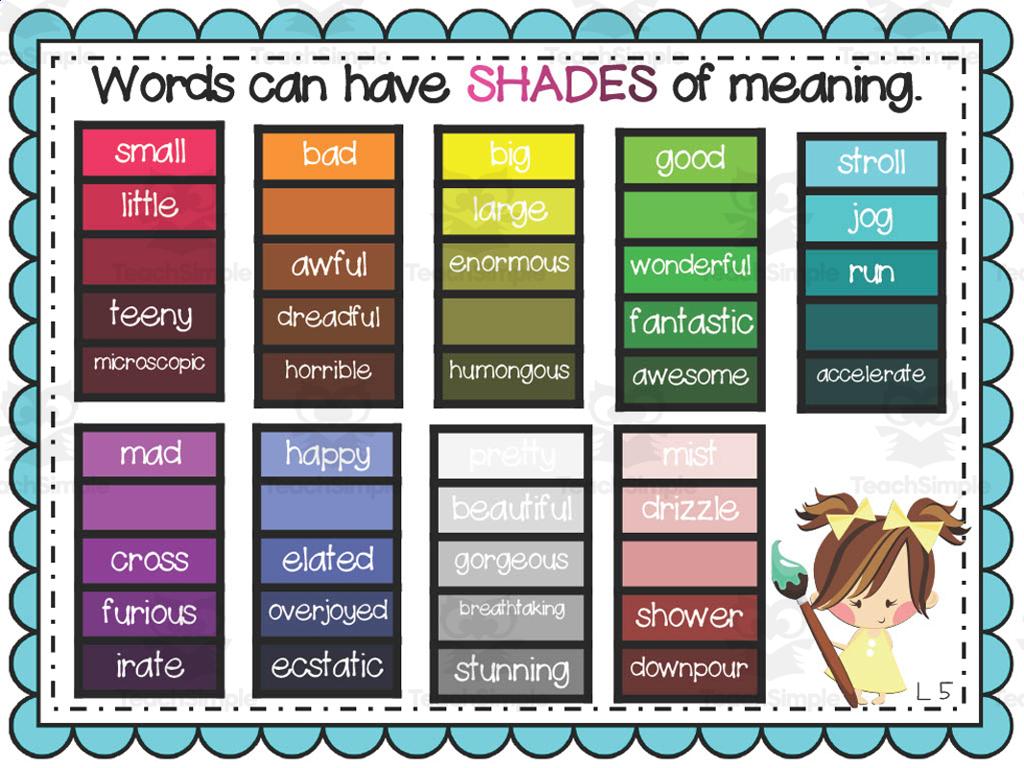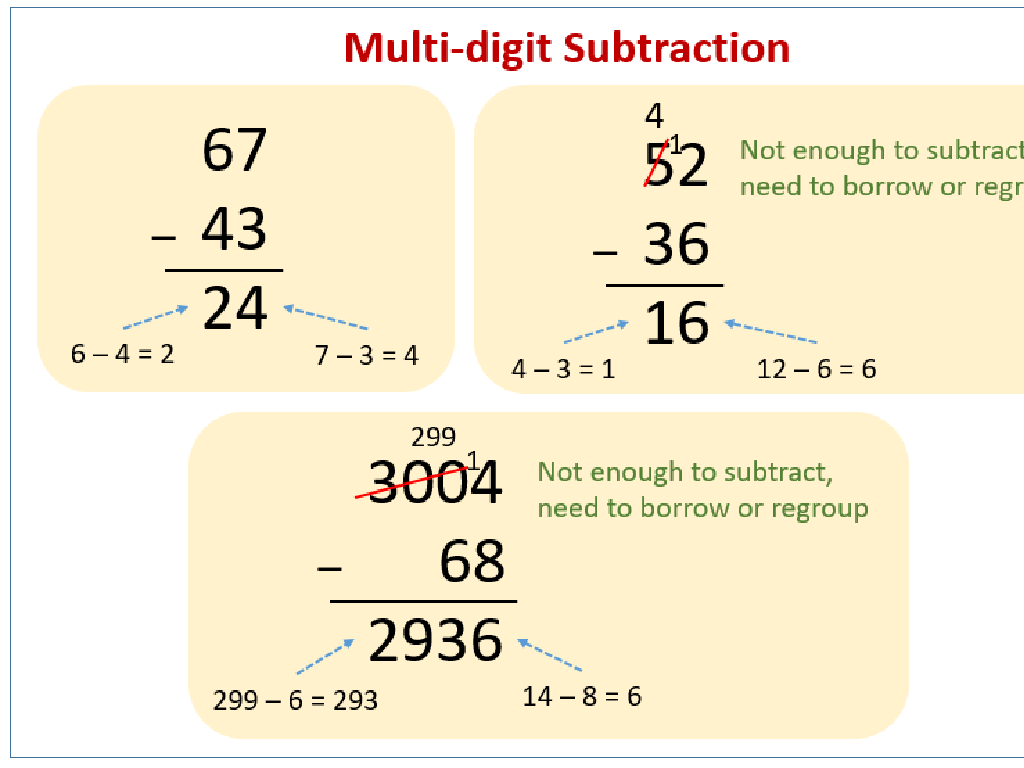Division Facts For 2, 3, 4, 5, And 10: True Or False?
Subject: Math
Grade: Third grade
Topic: Division Fluency Up To 10
Please LOG IN to download the presentation. Access is available to registered users only.
View More Content
Mastering Division Facts: True or False
– Today’s goal: Master division for 2, 3, 4, 5, 10
– Learn true or false division facts
– Use examples to spot true or false: 6 ÷ 2 = 3 (True), 9 ÷ 2 = 4.5 (False)
– Understand why division fluency matters
– Quick division helps in daily life, like sharing equally
– Practice makes perfect
– We’ll do fun activities to improve!
|
This slide introduces the objective of the class, which is to master division facts for the numbers 2, 3, 4, 5, and 10, and to understand the concept of true or false in division. Emphasize the importance of division fluency in everyday situations, such as dividing items equally among people. Provide clear examples of true or false division facts to help students recognize correct and incorrect division. Encourage students to practice regularly through engaging activities and games, reinforcing the idea that consistent practice leads to improvement in division fluency. Prepare a variety of exercises and real-life scenarios where students can apply their division skills to solve problems.
Understanding Division
– Division means sharing equally
– If you have 10 apples and 5 friends, how many does each get?
– It’s the opposite of multiplication
– Multiplying is combining groups, division is splitting into groups
– Examples: Dividing cookies or pencils
– 12 cookies shared by 4 friends means each friend gets 3 cookies
– Practice with true or false questions
|
This slide introduces the concept of division to third-grade students by relating it to the idea of sharing equally among friends. It’s important to emphasize that division is simply the reverse of multiplication. Use everyday examples like sharing cookies or pencils to make the concept relatable. Encourage students to think of division as a fair way to distribute items. To reinforce learning, incorporate true or false questions based on division facts for 2, 3, 4, 5, and 10, which will help students apply their understanding of division in a fun and interactive way. For example, ‘True or False: If I have 10 pencils and I share them equally with 2 friends, each friend gets 5 pencils.’ This approach will help solidify their division fluency up to 10.
Division Facts for 2: True or False?
– Dividing by 2 means equal parts
– Think of it like sharing equally with a friend
– Example: 10 ÷ 2 equals 5
– If you have 10 apples, and share with 1 friend, how many do each of you get?
– Practice division facts for 2
– True or False questions
– Get ready to answer if statements are true or false!
|
This slide introduces the concept of division by 2 as splitting something into two equal parts, which is a fundamental division fact for the number 2. Use the example of dividing 10 by 2 to illustrate this point. Encourage the students to visualize division as an act of sharing equally. After explaining the concept, engage the students with practice problems to reinforce their understanding. Conclude the lesson with a series of true or false questions to assess their grasp of division facts for 2. This interactive approach helps solidify the concept and prepares them for more complex division facts.
True or False: Division by 2
– Is 8 divided by 2 equal to 4?
– True, because 2 groups of 4 make 8
– Is 7 divided by 2 equal to 3?
– False, because 7 is not an even number
– Discuss your answers with a friend
– Explain why your answers are true or false
– Use objects like blocks to show division
|
This slide is an interactive class activity designed to help third-grade students understand division facts for the number 2. The first question reinforces the concept that 8 divided by 2 is indeed 4, which can be visualized by separating 8 objects into 2 equal groups. The second question introduces the idea that not all numbers divide evenly, as is the case with 7 divided by 2. Encourage students to discuss their reasoning with their classmates to foster collaborative learning. Provide manipulatives like blocks or counters to help them visualize the division process. The teacher should circulate the room to facilitate discussions, ensuring students articulate their understanding of why each statement is true or false.
Division Facts for 3: True or False?
– Understanding division by 3
– Dividing by 3 creates three equal groups
– Example: 9 ÷ 3 = 3
– 9 can be split into 3 groups of 3
– Practice division facts for 3
– Use objects to divide into groups of 3
– True or False activity
|
This slide introduces the concept of dividing by 3, which helps students understand how to split a number into three equal parts. Start with a clear example, such as 9 divided by 3, and explain that it means making 3 equal groups out of 9 items. Encourage students to visualize this by using physical objects like counters or drawing pictures. After the example, engage the class with a true or false activity where they determine if given division facts for 3 are correct. For instance, ’15 divided by 3 equals 5: true or false?’ This interactive approach reinforces their understanding and fluency in division facts for the number 3.
True or False: Division by 3
– Is 12 ÷ 3 equal to 4? True
– Is 10 ÷ 3 equal to 3? False
– Class activity: Solve together
– We’ll work as a team to solve these problems
– Understand division by 3
– Division by 3 means splitting into 3 equal groups
|
This slide is designed to engage the class in a true or false activity to test their understanding of division facts for the number 3. The first statement is true: when 12 is divided by 3, the result is 4, which means 12 can be evenly split into 3 groups of 4. The second statement is false: 10 divided by 3 does not result in a whole number, and the closest whole number is 3 with a remainder of 1. During the class activity, encourage students to work out these problems on the board or with manipulatives to visualize the division process. Emphasize the concept of equal groups in division and how it applies to dividing by 3. This interactive approach helps solidify their understanding of division facts and prepares them for more complex problems.
Mastering Division Facts for 4 and 5
– Understanding division by 4
– Dividing by 4 makes four equal groups
– Understanding division by 5
– Dividing by 5 makes five equal groups
– Example: 20 ÷ 4 = 5
– 20 cookies shared by 4 friends, each gets 5
– Example: 25 ÷ 5 = 5
– 25 stickers shared by 5 kids, each gets 5
|
This slide is focused on teaching third-grade students the concept of division as creating equal parts. When we divide by 4, we are splitting something into 4 equal groups, and similarly, dividing by 5 creates 5 equal groups. Use tangible examples like sharing cookies or stickers to make the concept relatable. During practice time, engage the class with similar division problems and encourage them to visualize the division process. This will help them understand and remember the division facts for 4 and 5. Make sure to provide immediate feedback and support as they work through the examples.
True or False: Division by 4 and 5
– 16 divided by 4 equals 4: True or False?
– 16 ÷ 4 = ? If we share 16 apples among 4 people, does each get 4?
– 15 divided by 5 equals 3: True or False?
– 15 ÷ 5 = ? If we have 15 candies and 5 friends, do we give 3 to each?
– Pair up for practice
– Discuss answers with your partner
– Talk about how you got your answers with a friend
|
This slide is designed to engage students in practicing division facts for 4 and 5 through a true or false activity. The first two bullet points present the students with simple division problems to solve. Encourage them to visualize the division as sharing equally among a group. The third point prompts them to work in pairs, fostering collaboration and discussion, which helps solidify their understanding. The final point encourages them to explain their reasoning, reinforcing their comprehension. As a teacher, walk around the classroom to assist pairs as needed, and consider discussing strategies like skip counting or using multiplication facts to check their division answers. After the activity, review the correct answers as a class and clarify any misconceptions.
Mastering Division Facts for 10
– Dividing by 10 simplifies numbers
– Think of it as removing the last zero of a number
– Example: 50 ÷ 10 equals 5
– If we take 50 and divide by 10, the zero drops off leaving us with 5
– Practice division by 10 together
– We’ll work on problems like 30 ÷ 10 and 80 ÷ 10 in class
– Understand the pattern for division by 10
– Notice how each time we divide by 10, the number gets 10 times smaller
|
This slide introduces third graders to the concept of dividing by 10. Start by explaining that when we divide a number by 10, it’s like taking away one zero from the end of the number. Use the example provided to illustrate this point. Then, engage the class with a few practice problems, such as 30 ÷ 10 and 80 ÷ 10, to reinforce the concept. Highlight the pattern that emerges when dividing by 10, emphasizing that the number becomes 10 times smaller. Encourage students to look for this pattern in different numbers and to understand that division by 10 is a consistent and predictable process. This will help build their confidence and fluency in division facts.
True or False: Division by 10
– 100 ÷ 10 equals 10: True or False?
– True, because 10 times 10 is 100
– 30 ÷ 10 equals 4: True or False?
– False, because 10 times 3 is 30
– Discuss with a partner to solve
– Share your answers with the class
|
This slide is designed to test students’ understanding of division facts related to the number 10. The first question checks if they know the result of dividing 100 by 10, which is a basic fact. The second question challenges them to identify a false statement, reinforcing their division skills. The Think-Pair-Share activity encourages collaborative learning and discussion among students. As a teacher, facilitate the activity by pairing students, guiding them through the process of solving the problems, and then asking them to share their findings with the class. This will help build their confidence in division and their ability to communicate mathematical ideas.
Class Activity: Division Bingo
– Play Bingo with division facts
– Solve division facts for your card
– Use facts for 2, 3, 4, 5, and 10
– Mark the correct answers on Bingo
– Aim for five in a row to win!
|
This interactive class activity is designed to help students practice and reinforce their understanding of division facts for 2, 3, 4, 5, and 10. Prepare Bingo cards with different division facts as the numbers. As you call out division problems, students will solve them and mark their cards if they have the answer. The first student to get five correct answers in a row (horizontally, vertically, or diagonally) shouts ‘Bingo!’ and wins. Possible variations of the game could include: 1) Group Bingo, where students work in small teams, 2) Mixed Operation Bingo, including multiplication facts to complement the division facts, 3) Timed Bingo, where students have a set amount of time to find as many facts as possible, or 4) Reverse Bingo, where students create their own problems that match the answers on the Bingo card.
Wrapping Up: Division Facts Mastery
– Congratulations on learning division facts!
– Homework: Division Facts worksheet
– Complete the worksheet for 2, 3, 4, 5, and 10
– Practice is key to perfection
– The more you practice, the better you’ll get!
– Ready for more fun with division?
|
As we conclude today’s lesson on division facts for 2, 3, 4, 5, and 10, commend the students on their hard work and understanding. For homework, they are assigned a worksheet that will reinforce their knowledge and provide additional practice. Emphasize the importance of regular practice to improve their division skills. Encourage them to approach the worksheet with a positive attitude and remind them that mastering division facts is a stepping stone to more advanced math concepts. In the next class, be prepared to review the homework, answer questions, and possibly conduct a fun activity to further solidify their understanding.





